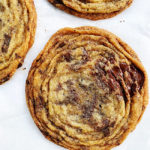
Pan-Banging Chocolate Chip Cookies
The original and famous Pan-Banging Chocolate Chip Cookies, created by Sarah Kieffer. The easy trick of banging the pan a few times during baking, causing the cookies to "fall," produces rippled edges that shatter in your mouth and a center that is soft and full of chocolate.
Servings 10 large cookies
Ingredients
- 2 cups (284 g) all-purpose flour
- ½ teaspoon baking soda
- ¾ teaspoon salt
- 2 sticks (227 g) unsalted butter, room temperature
- 1½ cups (297 g) granulated sugar
- ¼ cup (50 g) packed brown sugar
- 1 large egg
- 1½ teaspoons pure vanilla extract
- 2 tablespoons water
- 6 ounces (170 g) bittersweet chocolate, chopped into bite-size pieces averaging ½ inch with some smaller and some larger
Instructions
- Adjust an oven rack to the middle position. Preheat the oven to 350°F. Line 3 baking sheets with aluminum foil, dull side up.
- In a small bowl, whisk the flour, baking soda, and salt.
- In the bowl of a stand mixer fitted with a paddle, beat the butter on medium until creamy. Add the granulated and brown sugars and beat on medium until light and fluffy, 2 to 3 minutes. Add the egg, vanilla, and water and mix on low to combine. Add the flour mixture and mix on low until combined. Add the chocolate and mix on low into the batter.
- Form the dough into 3½-ounce (100g) balls (a heaping 1/3 cup each). Place 4 balls an equal distance apart on a prepared pan and transfer to the freezer for 15 minutes before baking. After you put the first baking sheet in the oven, put the second one in the freezer.
- Place the chilled baking sheet in the oven and bake 10 minutes, until the cookies are puffed slightly in the center. Lift the side of the baking sheet up about 4 inches and gently let it drop down against the oven rack, so the edges of the cookies set and the inside falls back down (this will feel wrong, but trust me). After the cookies puff up again in 2 minutes, repeat lifting and dropping the pan. Repeat a few more times to create ridges around the edge of the cookie. Bake 16 to 18 minutes total, until the cookies have spread out and the edges are golden brown but the centers are much lighter and not fully cooked.
- Transfer the baking sheet to a wire rack; let cool completely before removing the cookies from the pan.
Notes
These cookies are rather large, but to get the edges to spread out and crinkle, they need to be on the big side. If you want to make the cookies smaller, you won’t get as many ridges on the outer layer, and your center won’t be quite as gooey. They will still be delicious, but not quite what I intended for you.
If you skip freezing the cookies, they will spread too much on the pan and will not form the crinkly outer layer.
Chocolate chips are not a good substitution for the chopped chocolate; the cookies will not turn out the same with chips. If you do still want to use chocolate chips, you will need to use 8 ounces chips and make the cookies 2½ ounces big.
Using the dull side of aluminum foil to bake these cookies is a little trick I learned after hearing Alice Medrich speak. The foil helps make for an extra-crisp, golden brown bottom. Parchment paper can also be used with good results.
The cookies are delicious warm, but I’ve found I love them a couple of days later just as much. I usually store them in the fridge and sneak pieces of them cold.
*Throughout my recipes posted on this website, 1 cup of flour equals 142g. Please note that 1 cup of flour can range anywhere from 120g to 142g, depending on the baker or website. I found that after weighting many cups of flour and averaging the total, mine always ended up around this number. If I am posting a recipe from another cookbook, I will use whatever gram measure of flour used in that book, which is why you may see a few posts with a different cup measurement.
Different brands of flour have varying levels of protein, ranging from low to high, which can result in very different outcomes when baking. I've found Gold Medal all-purpose unbleached flour to be the best option for many of my recipes; I use it in all the baked goods that don't use yeast. For yeasted doughs that call for all-purpose flour, I like to use King Arthur Brand. If you are using White Lily flour, please note that it is a low protein flour and doesn't absorb liquid the same as regular all-purpose flours. Check the back of the flour bag for instructions on substituting it for regular all-purpose flours.
*Reprinted by arrangement with Avery Books, a member of Penguin Group (USA) LLC, A Penguin Random House Company. Copyright © Sarah Kieffer, 2016.